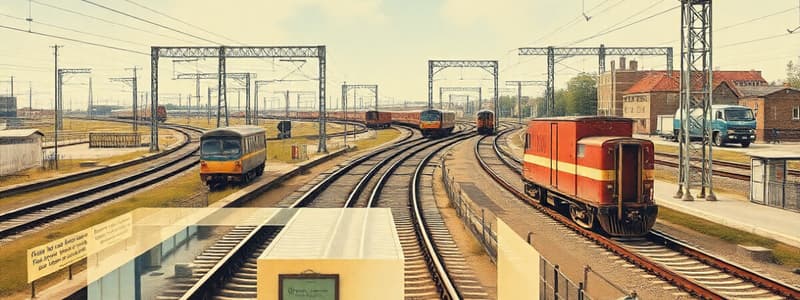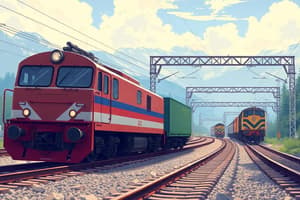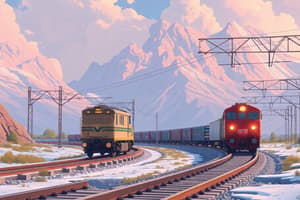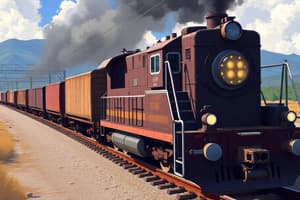Podcast
Questions and Answers
What should the Accounts Officers do with Transfer Certificates initially?
What should the Accounts Officers do with Transfer Certificates initially?
- Debit the Transfer head by the full amount immediately.
- Ignore the certificates until all invoices are received.
- Transfer the amounts to Miscellaneous Advances right away.
- Provisional debit to a relevant final head until acceptance. (correct)
How should the acceptance by departments be managed?
How should the acceptance by departments be managed?
- It should be recorded in an acceptance register. (correct)
- It is not needed if the bills are accepted quickly.
- It can be entered into any available spreadsheet.
- Departments are not required to provide any acceptance.
What is done if the received allocation differs from the original allocation?
What is done if the received allocation differs from the original allocation?
- The incorrect allocation should be reported to higher management.
- The transfer should be adjusted to the correct head. (correct)
- It should remain unmodified until the end of the year.
- None of the allocations should be changed.
What must happen to amounts that remain unadjusted at the close of the year in the 'Transfer' head?
What must happen to amounts that remain unadjusted at the close of the year in the 'Transfer' head?
What does the Traffic Accounts Branch need to do in case of through traffic?
What does the Traffic Accounts Branch need to do in case of through traffic?
What happens if there is no station open for goods traffic beyond the unloading station?
What happens if there is no station open for goods traffic beyond the unloading station?
What percentage concession is levied on train load charges for departmental wagons?
What percentage concession is levied on train load charges for departmental wagons?
How is a rattled RMC rake charged if it consists of multiple commodities with different rates?
How is a rattled RMC rake charged if it consists of multiple commodities with different rates?
What is required if a Railway Receipt (RR) is issued after the movement of Railway Material?
What is required if a Railway Receipt (RR) is issued after the movement of Railway Material?
What is the charge for wagon load of RMC materials in departmental wagons?
What is the charge for wagon load of RMC materials in departmental wagons?
What should happen if credit notes are not available by the end of the second month following an RR issuance?
What should happen if credit notes are not available by the end of the second month following an RR issuance?
What type of charges shall be levied based on the carrying capacity of departmental wagons?
What type of charges shall be levied based on the carrying capacity of departmental wagons?
What should be done if a consignment is diverted to a place farther than the farthest booking station?
What should be done if a consignment is diverted to a place farther than the farthest booking station?
What type of wagons do not incur siding charges when booking RMC materials?
What type of wagons do not incur siding charges when booking RMC materials?
What is required for a Credit Note to be deemed valid?
What is required for a Credit Note to be deemed valid?
What should be done if a Credit Note is found to be issued for unintended purposes?
What should be done if a Credit Note is found to be issued for unintended purposes?
What must be checked on the Abstracts of Railway Materials and Stores?
What must be checked on the Abstracts of Railway Materials and Stores?
What should happen if a transaction documented in Railway Material Consignment Notes is missing from forwarded abstracts?
What should happen if a transaction documented in Railway Material Consignment Notes is missing from forwarded abstracts?
How are charges for Railway Materials typically accounted for?
How are charges for Railway Materials typically accounted for?
What is required if a loading station is not accessible for goods traffic?
What is required if a loading station is not accessible for goods traffic?
Who should be notified of any instances of wrong use of Credit Notes?
Who should be notified of any instances of wrong use of Credit Notes?
What is the purpose of the Carriage Bill for Railway Materials and Stores?
What is the purpose of the Carriage Bill for Railway Materials and Stores?
Which section is responsible for preparing the journal slip upon receipt of the carriage bills?
Which section is responsible for preparing the journal slip upon receipt of the carriage bills?
How should adjustments of Carriage Bills for general service wagon be reflected?
How should adjustments of Carriage Bills for general service wagon be reflected?
What is the role of e-Recon in relation to Carriage Bills?
What is the role of e-Recon in relation to Carriage Bills?
Which heads are credited when preparing a journal slip for freight charges?
Which heads are credited when preparing a journal slip for freight charges?
What should the Traffic Accounts or General Accounts Section do after preparing the journal slip?
What should the Traffic Accounts or General Accounts Section do after preparing the journal slip?
In which manner can Carriage Bills be generated?
In which manner can Carriage Bills be generated?
What are the provisions for transferring funds from freight charges?
What are the provisions for transferring funds from freight charges?
What must accompany the transfer certificates sent to the Accounts Office?
What must accompany the transfer certificates sent to the Accounts Office?
What happens if the Carriage Bills relate to Foreign Railway?
What happens if the Carriage Bills relate to Foreign Railway?
How are freight charges apportioned for through Railway Materials and stores traffic?
How are freight charges apportioned for through Railway Materials and stores traffic?
What should be done in the case of non-accountal of traffic in the abstracts?
What should be done in the case of non-accountal of traffic in the abstracts?
Which documents are compared for local Traffic to ensure complete accounting?
Which documents are compared for local Traffic to ensure complete accounting?
In which format should Carriage Bills be prepared?
In which format should Carriage Bills be prepared?
How should the total freight mentioned in RR/e-TRR be apportioned?
How should the total freight mentioned in RR/e-TRR be apportioned?
What action is required for items less accounted for in forwarded abstracts?
What action is required for items less accounted for in forwarded abstracts?
What are Carriage Bills reconciled with?
What are Carriage Bills reconciled with?
What is the responsibility regarding the comparison of abstracts for through traffic?
What is the responsibility regarding the comparison of abstracts for through traffic?
What is the purpose of preparing carriage bills separately for departments?
What is the purpose of preparing carriage bills separately for departments?
What should be done if invoices are received in a different month from dispatch?
What should be done if invoices are received in a different month from dispatch?
What should be credited under Abstract Y-Goods earnings when handling carriage bills for general service wagons?
What should be credited under Abstract Y-Goods earnings when handling carriage bills for general service wagons?
Which step follows the preparation of a journal slip by the Traffic Accounts or General Accounts Section upon receipt of the carriage bills?
Which step follows the preparation of a journal slip by the Traffic Accounts or General Accounts Section upon receipt of the carriage bills?
What is the role of e-Recon in relation to managing carriage bills?
What is the role of e-Recon in relation to managing carriage bills?
In the case of Foreign Railway, how must the carriage bills be adjusted?
In the case of Foreign Railway, how must the carriage bills be adjusted?
What needs to accompany the transfer certificates sent to the Accounts Office for acceptance?
What needs to accompany the transfer certificates sent to the Accounts Office for acceptance?
What must be carefully examined when checking the Accounts copy of a Departmental Credit Note?
What must be carefully examined when checking the Accounts copy of a Departmental Credit Note?
In the context of railway materials and stores, what is required to be sent alongside two copies of the Credit Notes to the Traffic Accounts?
In the context of railway materials and stores, what is required to be sent alongside two copies of the Credit Notes to the Traffic Accounts?
What type of invoices should be bundled separately by each station as per the Accounts foil submission guidelines?
What type of invoices should be bundled separately by each station as per the Accounts foil submission guidelines?
Which document is crucial for ensuring proper accounting of Railway Materials and Stores for carriage by goods trains?
Which document is crucial for ensuring proper accounting of Railway Materials and Stores for carriage by goods trains?
How should Accounts Foils of all non e-TRR invoices be submitted according to the guidelines?
How should Accounts Foils of all non e-TRR invoices be submitted according to the guidelines?
What is the significance of the two copies of the Credit Notes when booking Railway Material consignments?
What is the significance of the two copies of the Credit Notes when booking Railway Material consignments?
Why is it important to ensure consignments are correctly treated as railway materials?
Why is it important to ensure consignments are correctly treated as railway materials?
How is the total freight mentioned in RR/e-TRR apportioned among railways for through traffic?
How is the total freight mentioned in RR/e-TRR apportioned among railways for through traffic?
What must be compared in local traffic to ensure all transactions have been accounted for?
What must be compared in local traffic to ensure all transactions have been accounted for?
What document should be prepared showing particulars of invoices and railway freight?
What document should be prepared showing particulars of invoices and railway freight?
What should be done if items are less accounted for in the forwarded abstracts?
What should be done if items are less accounted for in the forwarded abstracts?
In how many copies may carriage bills be prepared?
In how many copies may carriage bills be prepared?
Which actions should be taken regarding non-accountal of traffic in the abstracts?
Which actions should be taken regarding non-accountal of traffic in the abstracts?
What does the comparison of forwarded and received Railway Materials ensure?
What does the comparison of forwarded and received Railway Materials ensure?
Which of the following is considered when preparing carriage bills?
Which of the following is considered when preparing carriage bills?
What is the primary purpose of preparing carriage bills separately for each railway department?
What is the primary purpose of preparing carriage bills separately for each railway department?
What information must be included in carriage bills as per standard procedures?
What information must be included in carriage bills as per standard procedures?
What happens if the Railway Receipt (RR) is issued more than 15 days after the movement of Railway Material?
What happens if the Railway Receipt (RR) is issued more than 15 days after the movement of Railway Material?
Which of the following is true regarding charges for wagon loads during the busy season?
Which of the following is true regarding charges for wagon loads during the busy season?
How should charges be applied when a rake contains multiple commodities with different charge rates?
How should charges be applied when a rake contains multiple commodities with different charge rates?
What should be done if credit notes are not provided within the defined time frame after a consignment diversion?
What should be done if credit notes are not provided within the defined time frame after a consignment diversion?
What is the consequence of issuing the RR after moving the railway material, especially if it's beyond the 15-day limit?
What is the consequence of issuing the RR after moving the railway material, especially if it's beyond the 15-day limit?
Which charging policy applies to general service wagons?
Which charging policy applies to general service wagons?
What is necessary for a Credit Note to be considered valid?
What is necessary for a Credit Note to be considered valid?
What should be reflected if the RR is not issued within the time limit concerning future bookings?
What should be reflected if the RR is not issued within the time limit concerning future bookings?
In what situation should no siding charges be levied on loaded wagons?
In what situation should no siding charges be levied on loaded wagons?
Which action should be taken if a Credit Note is discovered to have been issued for unintended purposes?
Which action should be taken if a Credit Note is discovered to have been issued for unintended purposes?
What is the consequence of not securing credit notes by the end of the second month?
What is the consequence of not securing credit notes by the end of the second month?
What is the primary purpose of the super-cessional Railway Receipts issued?
What is the primary purpose of the super-cessional Railway Receipts issued?
What should happen if transactions documented in Railway Material Consignment Notes are found to be missing from forwarded abstracts?
What should happen if transactions documented in Railway Material Consignment Notes are found to be missing from forwarded abstracts?
What is required for the charging of Railway Material Consignments when the loading station is not open for goods traffic?
What is required for the charging of Railway Material Consignments when the loading station is not open for goods traffic?
Who should be notified in cases of wrong use of Credit Notes?
Who should be notified in cases of wrong use of Credit Notes?
During the check of Railway Receipts, what type of traffic are Railway Materials treated as?
During the check of Railway Receipts, what type of traffic are Railway Materials treated as?
What is the purpose of the checks performed on the invoices of Railway Material Consignment traffic?
What is the purpose of the checks performed on the invoices of Railway Material Consignment traffic?
What should be examined in the abstracts forwarded for Railway Materials?
What should be examined in the abstracts forwarded for Railway Materials?
How should transactions be handled when a loading station is not accessible for goods traffic?
How should transactions be handled when a loading station is not accessible for goods traffic?
Flashcards
Railway Material Consignment Note
Railway Material Consignment Note
A document used to record the delivery of railway material consignments. It should clearly show details of the material, the recipient, and the issuing office. It also requires official signatures and stamps for verification.
Credit Note misuse
Credit Note misuse
If a Credit Note is found to be used for purposes other than its intended use (for railway material consignments), a separate register should be maintained to record these instances.
Consignments for RVNL/Railway PSUs
Consignments for RVNL/Railway PSUs
When consignments are meant for RVNL/other Railway PSUs, the station needs to ensure the transaction is regularized with an RR reference. They may also need to collect cash or a demand draft from the relevant department.
Reporting Credit Note misuse
Reporting Credit Note misuse
Signup and view all the flashcards
Abstract check
Abstract check
Signup and view all the flashcards
Missing transactions in abstracts
Missing transactions in abstracts
Signup and view all the flashcards
Railway Material as ordinary traffic
Railway Material as ordinary traffic
Signup and view all the flashcards
Departmental Wagon Charges
Departmental Wagon Charges
Signup and view all the flashcards
Booking for Closed Stations
Booking for Closed Stations
Signup and view all the flashcards
RMC Material Charges
RMC Material Charges
Signup and view all the flashcards
Mixed Commodity Charges
Mixed Commodity Charges
Signup and view all the flashcards
Wagon Capacity and Charges
Wagon Capacity and Charges
Signup and view all the flashcards
General Service Wagon Charges
General Service Wagon Charges
Signup and view all the flashcards
Invoice and Credit Note Reference
Invoice and Credit Note Reference
Signup and view all the flashcards
Rail Receipt Issuance Time Limit
Rail Receipt Issuance Time Limit
Signup and view all the flashcards
Siding Charges Exemption
Siding Charges Exemption
Signup and view all the flashcards
Apportionment of Freight Charges
Apportionment of Freight Charges
Signup and view all the flashcards
Comparing Railway Material Abstracts
Comparing Railway Material Abstracts
Signup and view all the flashcards
Kilometrage Proportion
Kilometrage Proportion
Signup and view all the flashcards
Carriage Bill
Carriage Bill
Signup and view all the flashcards
Credit Notes
Credit Notes
Signup and view all the flashcards
Abstract Verification
Abstract Verification
Signup and view all the flashcards
Accounting for Missing Transactions
Accounting for Missing Transactions
Signup and view all the flashcards
Capital vs. Revenue Accounts
Capital vs. Revenue Accounts
Signup and view all the flashcards
CRIS (Computerized Reservation and Information System)
CRIS (Computerized Reservation and Information System)
Signup and view all the flashcards
Transfer Head Accounting
Transfer Head Accounting
Signup and view all the flashcards
Through Traffic Transfer
Through Traffic Transfer
Signup and view all the flashcards
Unallocated Funds
Unallocated Funds
Signup and view all the flashcards
Adjustment of carriage bills
Adjustment of carriage bills
Signup and view all the flashcards
Cost allocation for carriage in general service wagons
Cost allocation for carriage in general service wagons
Signup and view all the flashcards
Earnings credit for general service wagon freight
Earnings credit for general service wagon freight
Signup and view all the flashcards
Who adjusts carriage bills?
Who adjusts carriage bills?
Signup and view all the flashcards
Crediting freight charges in carriage bill adjustment
Crediting freight charges in carriage bill adjustment
Signup and view all the flashcards
Transfer certificates in carriage bill adjustment
Transfer certificates in carriage bill adjustment
Signup and view all the flashcards
e-Recon system in carriage bill adjustment
e-Recon system in carriage bill adjustment
Signup and view all the flashcards
Debit entries in carriage bill adjustment
Debit entries in carriage bill adjustment
Signup and view all the flashcards
Computerization in carriage bill adjustment
Computerization in carriage bill adjustment
Signup and view all the flashcards
Abstract of Railway Materials and Stores
Abstract of Railway Materials and Stores
Signup and view all the flashcards
Booking at nearest open station
Booking at nearest open station
Signup and view all the flashcards
Invoice credit note reference
Invoice credit note reference
Signup and view all the flashcards
Diversion/rebooking of departmental material
Diversion/rebooking of departmental material
Signup and view all the flashcards
Apportioning freight charges in through traffic
Apportioning freight charges in through traffic
Signup and view all the flashcards
Comparing Railway Materials and Stores records
Comparing Railway Materials and Stores records
Signup and view all the flashcards
What is a Carriage Bill?
What is a Carriage Bill?
Signup and view all the flashcards
What is CRIS?
What is CRIS?
Signup and view all the flashcards
Cost allocation for general service wagon carriage
Cost allocation for general service wagon carriage
Signup and view all the flashcards
Crediting freight revenue in carriage bill adjustment
Crediting freight revenue in carriage bill adjustment
Signup and view all the flashcards
What is the e-Recon system?
What is the e-Recon system?
Signup and view all the flashcards
Who adjusts the carriage bills?
Who adjusts the carriage bills?
Signup and view all the flashcards
Study Notes
Chapter XXXIV: Check of Traffic Relating to Railway Materials and Stores
-
Returns checked by Accounts Office. This chapter covers the checking and accounting of local/through traffic related to railway materials and stores carried by goods trains.
-
Departmental Credit Notes (COM/C-39): Documents authorizing the movement of railway materials.
-
Paid statement of Railway Materials and Stores forwarded (Local): (COM/R. 4 Revised): A statement detailing materials sent locally.
-
Paid statement of Railway Materials and Stores forwarded (Through): (COM/R. 5 Revised): A statement detailing materials sent through traffic.
-
Invoices/Accounts Foil of RMC entries: Records of invoices and accounts related to Railway Materials and Consignments (RMC).
-
Machine Prepared abstract of Railway Materials and Stores received (Local) (COM/R. 2 Revised): Summary of locally received materials.
-
Machine Prepared abstract of Railway Materials and Stores received (Through) (COM/R. 3 Revised): Summary of materials received through traffic.
-
Carriage bills/Transfer certificate for railway material and stores: Documents related to carriage and transfer of railway material.
Receipt of Accounts Foil of Departmental Credit Note for Booking of Railway Materials
- RMC invoices are issued by stations upon collection of credit notes.
- Two copies of the credit notes are remitted to Traffic Accounts.
- Accounts foils are submitted daily, or according to the specified timeframe, per station .
- Foils are categorized: Locally-paid & Through-paid.
- E-TRR invoices are downloaded from FOIS.
- The format for accounts foils follows Paragraph 2302 of the Indian Railway Accounts Code -II.
Check of Departmental Credit Notes
- Examine credit note details (consignor/consignee, nature of materials) to confirm they are railway-related.
- Ensure consignee and consignor are railway officials.
- Verify proper entry of all details (allocation, signatures).
- Incorrect credit notes are recorded in a separate register.
- Incorrect use of credit notes should be reported to the appropriate divisional and controlling officers.
Check of Abstracts of Railway Materials and Stores Forwarded (Local/Through)
- Review forwarded abstracts to ensure that each entry corresponds to a Railway Material Consignment Note.
- All transactions listed on notes must be present in the abstracts.
- Missing transactions should be added to the forwarded abstracts.
- Abstracts are cross-referenced with Railway Material Consignment Notes.
Check of Railway Receipts
- Railway materials are treated as standard public traffic.
- Freight and charges are collected through credit notes, during the booking/delivery process.
- Invoice verification process for RMC traffic is similar to the general process.
Charging of Railway Material Consignments
- Railway materials (including ballast) are charged at a standardized class rate from the loading to unloading station.
- If a loading station is closed, bookings are made from the nearest open station.
- An appropriate station for handling goods is chosen to align with the loading/unloading points.
- A 30% concession applies to the transport of consignments in departmental wagons.
- No extra charges apply to materials in departmental wagons (wagon load, busy season, development charges).
- Charges are based on the wagon's carrying capacity, as indicated.
- Different commodities in a wagon are charged according to highest class.
Wharfage and Demurrage Charges
- No demurrage levied for departmentally owned wagons.
- No demurrage on general service wagons, after condemnation, redirected to the engineering department.
- Wagon types like BOB, BOBY, and BOBYN don't incur demurrage charges, specifically when transporting engineering materials.
- Private or public traffic charges apply to these remaining wagons.
- Wharfage charges are not levied on RMC at railway premises used exclusively for RMC.
- If goods are handled at a goods shed, where items are handled for public traffic, the same wharfage rates apply to RMC.
Studying That Suits You
Use AI to generate personalized quizzes and flashcards to suit your learning preferences.
Related Documents
Description
This chapter delves into the processes involved in checking and accounting for traffic related to railway materials and stores. It discusses various documents such as departmental credit notes and statements for local and through traffic of railway materials, providing insight into the necessary records and abstracts required for effective management.




